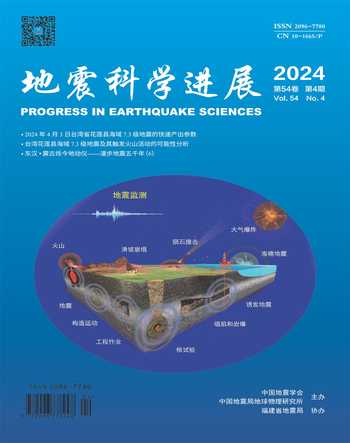2024年4月3日台湾省花莲县海域7.3级地震的快速产出参数
王钦莹 陈鲲 王永哲 张旭 张喆 王子博



[摘要] 2024年4月3日07时58分(北京时间)在台湾省花莲县海域发生7.3级地震。中国地震局地球物理研究所在震后启动快速响应,组织相关领域研究人员对此次地震的震源模型、地震辐射能量等进行了估计,同时基于震源模型进行了震动图模拟、同震形变场模拟。结果表明,此次地震发生在菲律宾海板块和欧亚板块的边界,以逆冲机制为主,呈现双侧破裂,能量集中在前约35 s内释放;极震区震动烈度可能达Ⅹ度以上,可能的受灾范围近35000 km2;此次地震引起了显著的同震位移,最大水平向位移达到0.52 m、垂直向位移达到 1.18 m。
[关键词] 台湾地震; 震源模型; 地震动强度预测; 地震辐射能量; InSAR; 同震形变场
[DOI] 10.19987/j.dzkxjz.2024-056
0 引言
据中国地震台网正式测定,北京时间2024年4月3日07时58分在台湾省花莲县海域发生7.3级地震,震源深度12 km,震中位于(23.81°N,121. 74°E)(图1)。此次地震发生在台湾花东纵谷断裂北段上。花莲位于欧亚板块和菲律宾海板块的交界线上,菲律宾海板块的斜向俯冲在台湾地区及其东部海域形成了特殊的地质结构,包括左旋走滑的纵谷断裂及近南北向逆断层系。这两个板块间的相互碰撞和俯冲导致了地壳的强烈缩短和斜向剪切变形,从而使得高震级地震在此地区频发。
震源特征、地震动强度和地表形变的估计,对于评估此次地震可能造成的震害具有重要意义。因此,2024年台湾花莲地震发生后,中国地震局地球物理研究所启动快速响应机制,组织相关研究人员产出了震源参数、地震辐射能量估计等,并开展了地震动强度预测、同震形变场模拟等工作,形成了具有重要意义的地震应急科技支撑产品。
1 震源模型
1.1 矩心矩张量反演
选择以常规WCMT[1-3]的技术流程处理本次事件。在反演时选用震中距在31.07°~89.61°之间的56道长周期垂直分量数据作为观测资料,利用W-phase进行矩心矩张量反演,滤波频带为0.0020~0.0067 Hz。在对矩心时空位置与矩张量解进行网格搜索后得到的最优模型结果表明,此次地震的标量地震矩为1.5×1020N·m、换算为矩震级MW=7.4,矩心时间13 s,半持续时间13.74 s,矩心坐标(24.02°N,121.66°E),矩心深度29 km。断层面解为节面I:走向15°、倾角61°、滑动角72°;节面II:走向228°、倾角34°、滑动角119°。双力偶成分占比91%,观测数据与合成数据整体相关度为0.94(图2~图3)。
1.2 震源破裂過程
采用的远震体波波形数据来自于IRIS 数据中心震中距在30°~90°范围内GSN 台网的宽频带地震仪。根据波形数据的信噪比水平和台站空间分布的均匀性,选取了其中34 个台站的垂直向记录。并采用ak135全球一维速度模型[4]和正交归一化方法[5]来计算理论格林函数。此外,本文采用了Zhang 等[6]发展的滑动角可变的时间域反演方法来反演震源破裂过程。该反演方法不需要预先给定子断层震源时间函数形状,而是通过共轭梯度法[7]迭代反演子断层震源时间函数,从而避免了先验假定给反演结果带来的影响,同时该反演方法允许子断层的滑动方向在给定的滑动角附近(± 45°)发生变化。
另外,为了稳定反演结果以使其具有可接受的物理意义,本文还引入了时间域和空间域光滑约束[6,8]以及标量地震矩最小约束[6,9-10]。 时间域光滑约束用于抑制子断层震源时间函数相邻时刻的不连续性,空间域光滑约束用于消除相邻子断层间位错的不连续性,而标量地震矩最小约束则用于压制较弱的过低频滑动。
初步反演结果(图4)表明,此次地震以逆冲机制为主,呈现双侧破裂,破裂持续时间不超过35 s,主要破裂长度约50 km。
2 地震动强度预测图
利用快速生成考虑场地效应的震动图方法[11],考虑地震的震中位置以及地震的震源机制解,计算了研究区范围内均匀网格点(30″×30″)上的基岩峰值加速度值;进一步考虑地震动参数的局部场地效应,将基岩峰值加速度值转换到地表土层上,获得了地表土层上的峰值加速度估计值,最后利用反距离权重法进行空间插值,获得峰值加速度在地表上的空间分布(图5)。
在计算过程中考虑了地震动的局部场地效应,其宏观场地分类的VS30数据是利用美国地质调查局地形坡度与VS30的相关关系获得的[11-15]。基岩地震动参数转换至地表土层,使用了由近地表剪切波速VS30量化的依赖于地震动幅值和频率的场地放大系数[15]。地震动衰减关系选用的是第四代区划图中中国西部长短轴峰值加速度衰减关系的几何平均值[16]。
根据对这次地震预测的震动图分布特征,预计极震区震动烈度可能达Ⅹ度以上,可能的受灾范围近35000 km2。
3 地震辐射能量估计
利用全球地震台网(GSN)提供的宽频带记录,基于能流密度法[17]开展了此次地震的震源参数测定(图6),结果显示本次地震的辐射能量为5.6×1015J,折合能量震级Me为7.6,结合1.1节给出的矩震级结果MW7.4,可知Me>MW,因此,该地震作为一次逆冲型地震,震源辐射地震能量的效率偏高,与相似矩震级的地震相比,造成震动的能力较强,存在引发局部海啸的风险。
4 三维及InSAR同震形变场模拟
基于均匀弹性半空间位错模型[18]和震源机制解,模拟了此次地震的三维同震形变场,并利用 Sentinel-1卫星的 SAR成像几何参数分别计算了升、降轨 InSAR地表形变干涉图(图7)。模拟中所用的 SAR成像几何参数包括卫星的飞行方位角和雷达入射角,升轨成像的参数分别为 –12.9°和 39.7°,降轨成像的参数分别为 –167.0°和 39.7°。模拟结果显示,此次地震引起了显著的地表同震位移,最大水平向位移达到 0.52 m、垂直向位移达到1.18 m。该结果对于海啸发生的判断、震害的评估以及是否可利用InSAR观测到显著的地表形变具有参考意义。
Simulated ascending (a) and descending (b) interferograms, each fringe represents 2.8 cm surface displacement along the Radar line-of-sight; (c) Simulated three-dimensional deformation field, arrow vectors represent the horizontal displacements
5 结论
中国地震局地球物理研究所针对 2024 年4月3日07时58分(北京时间)发生于台湾省花莲县海域的 7.3 级地震启动了应急快速响应,组织相关领域研究人员进行应急产品快速产出,产品主要包括此次地震震源机制、震源破裂过程、震动图分布特征、地表同震位移和地震辐射能量等,得到的主要结果如下:
(1)此次地震发生在菲律宾海板块和欧亚板块的边界,标量地震矩为1.50×1020N·m、换算为矩震级MW7.4,矩心时间13 s。
(2)震源破裂过程研究表明,此次地震以逆冲机制为主,呈现双侧破裂,破裂持续时间不超过35 s,主要破裂长度约50 km。
(3)根据对这次地震预测的震动图分布特征,预计极震区震动烈度可能达Ⅹ度以上,可能的受灾范围近35000 km2。
(4)同震形变场模拟结果显示,此次地震引起了显著的地表同震位移,最大水平向位移达到 0.52 m、垂直向位移达到1.18 m。
(5)地震能量测定结果显示,此次地震的辐射能量为5.6×1015J,折合能量震级Me为7.6,震源辐射地震能量的效率偏高,与相似矩震级的地震相比,造成震动的能力较强,存在引发局部海啸的风险。
参考文献
- Kanamori H,Rivera L. Source inversion of W phase:Speeding up seismic tsunami warning[J]. Geophysical Journal International,2008,175(1):222-238
- Duputel Z,Rivera L,Kanamori H,et al. W phase source inversion for moderate to large earthquakes (1990—2010)[J]. Geophysical Journal International,2012,189(2):1125-1147
- 张喆,许力生. 2013年南斯科舍海岭MW7.8地震的多点震源机制反演[J]. 地球物理学报,2020,63(8):2978-2998 Zhang Z,Xu L S. 2013 MW7.8 South Scotia Ridge earthquake:Focal mechanism inversion of the multi-point sources[J]. Chinese Journal of Geophysics,2020,63(8):2978-2998
- Kennett B L N,Engdahl E R,Buland R. Constraints on seismic velocities in the Earth from traveltimes[J]. Geophysical Journal International,1995,122(1):108-124
- Wang R J. A simple orthonormalization method for stable and efficient computation of Greens functions[J]. Bulletin of the Seismological Society of America,1999,89(3):733-741
- Zhang Y,Feng W P,Chen Y T,et al. The 2009 LAquila MW6.3 earthquake:A new technique to locate the hypocentre in the joint inversion of earthquake rupture process[J]. Geophysical Journal International,2012,191(3):1417-1426
- Ward S N,Barrientos S E. An inversion for slip distribution and fault shape from geodetic observations of the 1983,Borah Peak,Idaho,earthquake[J]. Journal of Geophysical Research:Solid Earth,1986,91(B5):4909-4919
- Yagi Y,Mikumo T,Pacheco J,et al. Source rupture process of the Tecomán,Colima,Mexico earthquake of 22 January 2003,determined by joint inversion of teleseismic body-wave and near-source data[J]. Bulletin of the Seismological Society of America,2004,94(5):1795-1807
- Hartzell S H,Heaton T H. Inversion of strong ground motion and teleseismic waveform data for the fault rupture history of the 1979 Imperial Valley,California,earthquake[J]. Bulletin of the Seismological Society of America,1983,73(6A):1553-1583
- Antolik M,Dreger D S. Rupture process of the 26 January 2001 MW7.6 Bhuj,India,earthquake from teleseismic broadband data[J]. Bulletin of the Seismological Society of America,2003,93(3):1235-1248
- 陳鲲,俞言祥,高孟潭. 考虑场地效应的ShakeMap系统研究[J]. 中国地震,2010,26(1):92-102 Chen K,Yu Y X,Gao M T. Research on ShakeMap system in terms of the site effect[J]. Earthquake Research in China,2010,26(1):92-102
- Wald D J,Allen T I. Topographic slope as a proxy for seismic site conditions and amplification[J]. Bulletin of the Seismological Society of America,2007,97(5):1379-1395
- Allen T I,Wald D J. On the use of high-resolution topographic data as a proxy for seismic site conditions (V S)[J]. Bulletin of the Seismological Society of America,2009,99(2A):935-943
- Heath D C,Wald D J,Worden C B,et al. A global hybrid V S map with a topographic slope-based default and regional map insets[J]. Earthquake Spectra,2020,36(3):1570-1584
- Borcherdt R D. Estimates of site-dependent response spectra for design (methodology and justification)[J]. Earthquake Spectra,1994,10(4):617-653
- 汪素云,俞言祥,高阿甲,等. 中国分区地震动衰减关系的确定[J]. 中国地震,2000,16(2):99-106 Wang S Y,Yu Y X,Gao A J,et al. Development of attenuation relations for ground motion in China[J]. Earthquake Research in China,2000,16(2):99-106
- Newman A V,Okal E A. Teleseismic estimates of radiated seismic energy:The E/M0 discriminant for tsunami earthquakes[J]. Journal of Geophysical Research:Solid Earth,1998,103(B11):26885-26898
- Okada Y. Surface deformation due to shear and tensile faults in a half-space[J]. Bulletin of the Seismological Society of America,1985,75(4):1135-1154
Quick output parameters related to the 3 April 2024 M7.3 earthquake in the sea area of Hualien County,Taiwan Province
Wang Qinying*, Chen Kun, Wang Yongzhe, Zhang Xu, Zhang Zhe, Wang Zibo
Institute of Geophysics, China Earthquake Administration, Beijing 100081, China
[Abstract] On April 3, 2024, at 07:58 (Beijing time), a magnitude 7.3 earthquake occurred in the waters of Hualien County, Taiwan Province. The Institute of Geophysics, China Earthquake Administration initiated a rapid response after the earthquake and organized geophysics researchers to estimate the source model and seismic radiation energy of the earthquake. Based on the source model, the shakemap and coseismic deformation field simulation were carried out. The results indicate that the earthquake occurred at the boundary between the Philippine Sea Plate and the Eurasian Plate, primarily characterized by a thrust mechanism, with energy released predominantly in the first 35 seconds. The earthquake intensity in the extreme seismic area possibly have reached more than X degree, with a potential disaster area of approximately 35000 km2. The earthquake also caused significant coseismic displacements, with the maximum horizontal displacement reaching 0.52 m and the vertical displacement reaching 1.18 m.
[Keywords] the Taiwan earthquake; seismic source model; shakemap prediction; earthquake radiation energy; InSAR; coseismic deformation

